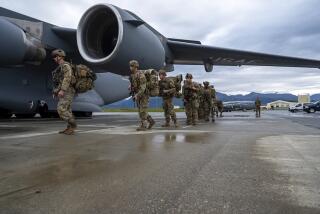THE WORLD - News from June 19, 2009
- Share via
WASHINGTON — Reacting to reports that North Korea may be preparing to test-fire a missile toward Hawaii, Defense Secretary Robert M. Gates said Thursday that he had ordered additional assets deployed to shore up defense of the islands.
Gates ordered the deployment of a powerful sea-based radar system that can help closely track the path of intercontinental ballistic missiles and also sent terminal-phase missile interceptors to Hawaii.
The comments may be intended to deter North Korea from attempting another long-range missile launch and to reassure allies that the United States is willing to act to prevent a successful test by the government in Pyongyang.
According to reports in Japanese media, the North Koreans appear to be preparing to conduct their next long-range test around July 4. Experts believe that because the last long-range missile test failed, Pyongyang has more to prove and may see another test as necessary.
Although Gates did not explicitly say that the U.S. would try to shoot down a test missile aimed in the direction of Hawaii, he noted that interceptor missiles in California and Alaska were ready.
“The ground-based interceptors are clearly in a position to take action,” Gates said. “So without telegraphing what we will do, I would just say, I think we are in a good position, should it become necessary to protect American territory.”
Victor D. Cha, a scholar at the Center for Strategic and International Studies, said Gates’ comments could be intended as a deterrent.
“It is probably to let the North Koreans and the world know we are going to prepare a response if they are going to continue to launch missiles, particularly if they are going to launch it in the direction of Hawaii,” said Cha, who was President George W. Bush’s top advisor on North Korea.
This week, Marine Gen. James Cartwright, the vice chairman of the Joint Chiefs of Staff, said that he was “90%-plus” confident the U.S. could shoot down a North Korean missile
Gates’ more assertive language shows a deeper confidence by the military and government in the missile defense system, Cha said.
“We are just more capable now,” Cha said. “We are much more willing to say we are preparing missile defenses if we are confident we would be able to take something out either in the boost phase or on a ballistic path.”
Theater missiles in the Pacific Ocean, which target the boost phase, or the mid-course interceptors in Alaska and California would probably be the ones most likely to shoot down a North Korean missile.
The Terminal High Altitude Area Defense, or THAAD, missiles that Gates deployed to Hawaii are meant to shoot down missiles minutes before they strike their target. Meant for short-range missiles, they have not been tested on long-range rockets.
The sea-based radar system, known as the SBX, had been docked in Hawaii for maintenance and repairs and was not deployed when the North Koreans shot a Taepodong 2 rocket in April.
Missile defense experts said that if the system had been deployed, the U.S. would have been able to gather more information about that launch.
The SBX was due to deploy anyway to participate in planned missile defense tests this summer. But by linking the deployment to the prospect of another North Korean test, Gates appears to be sending a signal that the U.S. might try to shoot down a missile from Pyongyang.
Before April’s launch, military officials suggested the U.S. could destroy the rocket, but Gates publicly tamped down speculation that the defense system would be used.
Thursday, Gates said the Defense Department was watching the situation closely.
“We do have some concerns, if they were to launch a missile . . . in the direction of Hawaii,” he said.
Military officials are also tracking a North Korean ship that has been involved in transporting weapons in the past. The Kang Nam left North Korea on Wednesday.
A new United Nations resolution allows other nations to ask to search North Korean ships or inspect them when they make port calls if the vessels are suspected of smuggling arms or nuclear material.
--
More to Read
Sign up for Essential California
The most important California stories and recommendations in your inbox every morning.
You may occasionally receive promotional content from the Los Angeles Times.










